A plant disease that stunts the growth of banana plants and deforms their fruit has been found north of Hilo, where farmers worry it could find its way into the deep gulches of the Hamakua Coast, making containment a more difficult task.
The banana bunchy top virus, which jumps from plant to plant with the help of aphids, was first found on Oahu in the 1989 and arrived in Kailua-Kona in the following decade.
Despite a quarantine effort on the leeward side, the virus cropped up on a farm in Keaau in 2004 and has since spread over much of Hilo and Puna, where growers say it has become entrenched. It’s also found in North Kohala.
The remedy is to spray infected plants with insecticide to get rid of the disease-carrying aphids and destroy the plant, typically done by injecting it with the Roundup herbicide.
But that only limits the damage.
Lynn Richardson said every week he finds infected banana plants on his 6-acre farm in Kurtistown.
“This year, I’ve cut down 200,” he said. “I can’t replace them all, so there will be losses.”
On a recent morning, he pulled out a screwdriver and poked a hole in a plant with the telltale signs of the disease — stunted growth and discolored edges on its leaves — before injecting the herbicide.
With infected plants, both wild and homegrown, “1,000 feet in every direction” outside his property, he said he knows he will be doing the same again next week.
Farmers on the Hamakua Coast so far have been spared, but that could soon change.
Within the last year, the state Department of Agriculture confirmed the presence of the disease around Paukaa.
If it keeps moving north, Richardson said he and other banana farmers fear it will get into the ravines where it can be impossible to remove.
“If it gets in the gulches, it’s over,” he said.
A farmer north of Hilo is already experiencing the disease, and not for the first time.
Richard Ha, who abandoned a banana farm in Keaau after being hit hard by the disease 12 years ago, said his farm in Pepeekeo is already seeing signs of bunchy top.
“We actually found some on our own farm less than a month ago,” he said.
“The worry, of course, is if they get embedded in the gulches and you can’t get to them, then it’s a real problem. To me, that’s inevitable.”
Richardson said the state needs to be more aggressive in controlling the disease.
He points to Australia, which he says has been able to contain the disease by giving officials authority to destroy infected crops on private property without notice. Property owners in areas with the disease also are only permitted to plant bananas where they can be seen from the street, allowing infected plants to be be easily spotted and removed.
“This is what works,” Richardson said. “In (the state’s) attempt to reinvent the wheel, they failed.”
Ha, who also sits on the state Board of Agriculture, said he would also like to see an approach like that used here.
“I don’t think Hawaii has the stomach to pass a law like that,” he added.
In 1999, the Department of Agriculture introduced a plant quarantine and oversaw the elimination of all banana plants in a 10-square-mile area of Kailua-Kona in an attempt to stop the disease from spreading around the Big Island.
While the signs remain, Kamran Fujimoto, a Department of Agriculture noxious weed specialist in Hilo, said the program has long been disbanded. The disease just kept coming back.
“We left the signs up as a reminder that this was a heavily infected area,” he said.
The state has since switched from an eradication strategy to focusing on management, but such efforts are hindered by staff cuts and inability to force property owners to destroy infected plants without a court order.
Fujimoto said he tries to educate residents about the disease if he sees it at their home, but that’s not always successful.
Some are leery about using Roundup to kill infected plants.
He’s also a one-man operation.
“Because of the budget cuts, our department took a big hit,” Fujimoto said.
“We are trying to restaff; we don’t know how long it’s going to be.”
He said the disease has become more prevalent in Hilo over the last few years, and he has found it as far into Puna as Orchidland.
Fujimoto said he also is worried about the disease getting into the gulches.
“Getting down there is a challenge in itself,” he said. “And, in some parts, the bananas are probably growing along the side of a bank. You probably can’t even get to them.”
Even if that doesn’t occur, growing bananas in Hilo could become a challenge if it remains unchecked, he said.
“In heavily infested places like Oahu, they are having a hard time growing bananas in their backyards,” Fujimoto said.
Apple bananas have more tolerance to the disease than the Cavendish variety Richardson mostly grows, but he said switching varieties alone isn’t a solution.
“It’s more like going to war with a better gun, but you still end up getting shot at,” he said.
Richardson said farmers need assurance that plant diseases can be controlled. He would like to see the state do more, both in controlling bunchy top and preventing other diseases from arriving.
“We just need to get to the point where people aren’t afraid to farm,” Richardson said.
“… If we can limit it to one or two (infected) plants every couple months, we can live with that.”
Email Tom Callis at tcallis@hawaiitribune-herald.com.
SIDEBAR
With the banana bunchy top virus still spreading across the Big Island, could genetic modification be a solution?
John Hu, a plant and environmental protection sciences professor at University of Hawaii at Manoa, said he is working with a researcher in Kenya on creating the first banana resistant to the disease, found in banana-growing regions outside central and South America.
He recently applied for a permit to import 300 transgenic banana plants from Kenya to determine their resistance levels, and hopes to begin greenhouse trials shortly.
The research could take three to five years and, if successful, could help banana farmers stay afloat, Hu said.
“What we’re trying to do is help growers here in Hawaii and potentially to help farmers in Africa and other countries, including other Pacific Island countries,” he said.
The technique, called “gene silencing,” prevents the plants from producing the bunchy top virus protein gene when aphids introduce the disease, effectively providing them with immunity.
If introduced, it wouldn’t be the first crop on the island modified to resist a disease. In the 1990s, the transgenic Rainbow papaya was developed, helping farmers fight back against the ringspot virus.
Much like the Rainbow papaya, the plants Hu is working on would only be resistant to a disease, and would not, unlike the majority of genetically modified plants in use, be designed to tolerate herbicides or produce their own pesticides.
But whether they get used will likely depend on the response from consumers.
A couple years ago, hundreds of GMO opponents packed the Hawaii County Council chambers as council members considered a bill banning nearly all new transgenic crops. The law passed but it was later overturned in federal court.
The county has appealed that ruling to the U.S. Ninth Circuit Court of Appeals.
Asked about the development of a virus-resistant banana, Kohala Councilwoman Margaret Wille, who introduced the bill, said any introduction of new transgenic crops should be done carefully.
Her law would have banned any open-air use of transgenic crops, while providing exemptions for farmers already using modified plants. That would have essentially outlawed the introduction of a bunch top-resistant banana on the island, though the law would have allowed the council to consider an “emergency exemption” for new virus-resistant crops.
“I think we need to be concerned,” Wille said. “If our law was in place, it would say, ‘Come forward and show us (there’s a need).”
Since bananas don’t produce seeds, farmers wouldn’t have to worry about cross-pollination between transgenic and non-transgenic varieties, Hu said.
While it might not be a solution for certified organic farmers, Puna banana farmer Lynn Richardson said genetic modification is something growers should consider. He doesn’t see consumer acceptance being a major issue.
“I think most people don’t care,” he said, adding he does share concerns regarding use of herbicide-resistant crops.
“The thing is, the world is getting smaller. Stuff is jumping borders right and left, and genetic altering for disease prevention is about the only thing we are going to be able to do.”
BOX
Banana facts
Acres bearing fruit on Big Island:
2012: 472
2007: 991
2002: 903
Statewide production:
2014: 14,400 pounds
*Source: U.S. Department of Agriculture
How to spot banana bunchy top:
– New leaves are more narrow, are yellow along their margins, and are “bunched” at the top.
– Initial symptoms include dark green streaks or hook-like extensions in the veins of leaves.
For more information, visit https://www.ctahr.hawaii.edu/bbtd/.
To report a suspected bunchy top infection, call Hawaii Department of Agriculture in Hilo at 974-4145 or email kamran.g.fujimoto@hawaii.gov.













